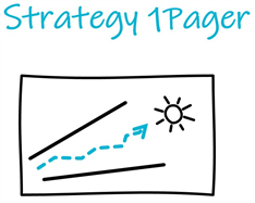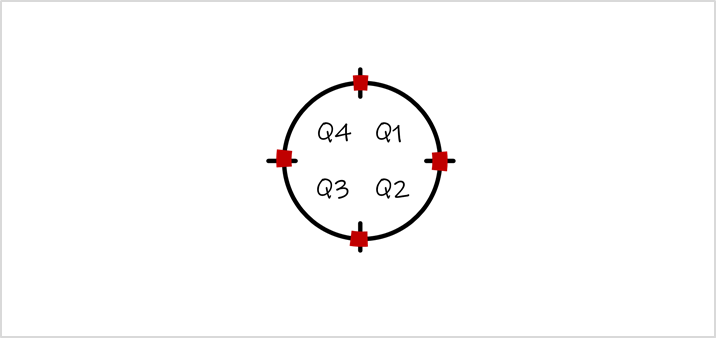
Quarterly Goals — 2.09
Markus Westerlund
Share this blog
Today’s topic is about setting quarterly strategic goals. How does it work? This is so very important. We all believe in the power of goals. In big corporations this is very complicated. In smaller businesses the strategic goals go intuitively with the flow: When one goal is completed, it is replaced with the next goal. However, when a company grows to a point where it employs 20-30 people, there comes a need to organize: Who is in charge of what and what is the common direction everyone is heading towards?

Behold, the “thingamajig” which we both love and hate. It’s the hierarchical organization, but a hierarchical organization has many perks. There’s no need to get rid of it. My favorite thing is to add agile teams on top of it, where the groups work as if doing tiny projects, with the hierarchical organization remaining in the background.

I call this a hybrid organization. Teams create goals easily, and they are almost “disposable goals”. Once the goals have been reached, the team is done with work.
The question is: What is the world’s greatest way to create goals for a background hierarchy? Why is it that many companies are almost obliged to build this kind of hierarchy?
Goals. How?

Nowadays, it is discussed if self-management could replace a hierarchy. I was invited to comment on a result about self-management composed by a group of scientists. There are many ways to become organized, but this hybrid combination is powerful. A successful pioneer leader once called a completely self-managing organization a “freak ball”. In the Finnish Defense Forces, it’s a term for when everything goes in different directions. He was of the opinion that self-management totally sucked. It’s very difficult if we’re lacking a common ground to build upon.
Agility is needed, as well as hierarchy, the hybrid. How could we create more efficient goals for the hierarchy? Legislation demands a company to have an accounting period. That’s why goals are set for the next accounting period so that the risk-takers, meaning the owners, know what the company is aiming at and they know what kind of revenue to expect for their investment.
A pressure to create big goals and make big choices and to pursue them exists. How could one do this better than ever before? Let me introduce a system, where the point is to create goals quarterly.

Let’s begin naturally by having one big goal. Investors always say that they work backwards. First, it’s necessary to think about what needs to be done, then it’s time to go back to look at what kind of goals are needed. The big dartboard symbolizes the big goal. Now let’s start going backwards.
Yearly clock?

Do we do top-down or bottom-up? Both are possible. Is the magic after all in doing both simultaneously like in the hamburger model? I believe that once the big picture has been painted, the departments are asked what they think should be done during the next season. The answers are combined and checked if they are a good enough combination. If not, a new suggestion is requested.
When people are given the right and the possibility to give their opinion on what a good goal is, it motivates them very much. My good friend Bo Harald said that he would have never had the guts to set as tough goals as his team did.
Quarterly goals

This is the yearly clock. In practice, many organizations feel forced to follow the yearly clock: The strategy is created during spring and the operating plan and the budgeting is done in the autumn. After that, goals are set for the next year.
I have begun to challenge this idea. Is this the most reasonable way? Is it enough that once a year we think about our strategy and create strategic goals? My answer is that its time is over. We need a better and more robust way of working than a mechanic yearly clock like this.
I know an organization where its CEO says that they create a strategy always when they feel up for it. That’s a nice idea.
Because it’s so hard to get rid of the yearly clock, what if we did this instead?
Quarterly strategy checkups

Let’s break down the yearly strategy into a quarterly strategy. Let’s make significantly shorter and faster sprints. Every now and then, maybe every third year, it’s worth doing a larger job and analyzing everything more in-depth. Once this is done, quarterly strategy updates can be done and goals for the next quarter can be chosen. This in my opinion is amazing, because it leads to an agile way of operating. Nothing is set in stone! The direction of the company is observed constantly.
Next goals

In practice, it works so that all the quarterly meetings with the management group are scheduled and marked in everyone’s calendars. Then the department leaders prepare for the meeting by asking what should be done next. They bring suggestions for the next quarter’s goals. At the same time, last year’s goals are checked to see if they were achieved or not. What did we learn? How do we succeed even better next time?
Quarterly checkups are one-day or two half-day online meetings, in which the strategy is gone through. The living digital board has the whole strategy displayed, including the previous and the new upcoming goals. Everyone is able to write on the board simultaneously. This leads to people checking up on the strategy frequently, and, if the strategy needs changing, it’s noticed faster.
Agile goals

Then, in practice, the department leader makes a suggestion for the next goals. They are discussed with the CEO and their colleagues, whether or not they’re relevant. At the same time, the entirety is checked to see if the big goals are still relevant and reasonable, or if they need a fix-up. Fix-ups are done often, and what’s better than that!
Following up on the strategy
Once the meeting is at an end, the management group has commented on the most important goals – those that truly steer the boat. Operative goals won’t necessarily be quarterly goals, because they can be updated and fixed inside the departments. The focus is on the bigger strategic goals, the levers that move big stones out of our way.
After the meeting, the management group meets with its team to discuss how the big goals are broken down into smaller issues. They have discussed this already previously, now they are merely doing check-ups to clarify everyone’s on the same page. In the end, everyone needs to know their job and goals that need to be accomplished.
This creates a hierarchy of goals, but I think it’s a good thing. Especially if it’s treated in a manner that they can live and change in the process. When a goal is reached, the next most important thing is brought up to be looked at. Strong prioritizing and challenging, sprint thoughts!

Strategy on one page
I strongly believe that the core strategy should be written down on one piece of paper, the Strategy 1Pager. The strategy is actually the cornerstones of the sectors, it determines the direction. Then, everyone can define how to sail forward every day. Strategy = HOW.
Quarterly strategic goals live constantly within the direction the company is headed to. The direction is steered by the sun, our Purpose: What is the goodness we bring to our customers and to the universe? The numbers are the result of the purpose, not the other way around. First, you need the purpose. That is what produces the numbers. I believe this creates a better win-win-win situation. Everyone earns more money: the customer – company – individual.
The question is how to steer ourselves optimally towards the sun. This is like a sailing boat, which constantly needs to be aware of the direction of the wind. That’s the job of an agile organization.

Conclusion: Make people take a pit stop quarterly. In small businesses the goals are checked up weekly or monthly. If you’re working in a bigger company, operate at least one every quarter.
Strategy board

Use the strategy board! The strategy board is where you list all the focus areas and their biggest breakthrough goals. This is very important. These Trello cards are updated monthly in every management group meeting. Do check-ups of how the job proceeds. In its weekly operation, the management group follows up on the implementation of the sub-goals. Are things proceeding, or aren’t they?

This quarterly goal idea is absolutely solid! I truly recommend it if you happen to have a bigger-than-average organization. Even if you had a group of ten people, the strategic goals are good to be listed on a digital strategy board. It’s solid! That’s how you won’t even notice the strategy has changed because it happens naturally. The gap between the strategy and operative tasks has closed.
This is how you IGNITE YOUR STRATEGY! Read more.🔥
Recent Posts
Stradigo
Stradigo is a brand owned by Rdigo Oy (Business-ID: 2120844-1).
Learn more from our Imprint.
Rdigo Oy is registered in Finland as a Limited company. We are a strategy consultancy located in the Helsinki capital region.
We’ve been in business since 2007. The company name comes from the latin word Redigo, meaning both ‘I shape’ & ‘I renew’.
Stradigo combines the word strategy with Rdigo.
